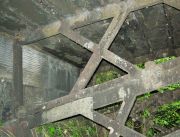Cambus Iron Bridge













in Cambus, near Alloa, Clackmannanshire
This is a very fine early cast iron bridge crossing the River Devon, presumably built to serve the Cambus Distillery.
Surprisingly, neither the construction date nor the maker have been identified.
65 ft span, 7 ft rise [1]. The 12 ft wide wooden deck is supported by four cast iron ribs. The four ribs can be seen in photo 4. Each of these ribs is assembled from three main castings. The outboard ends of the main ribs press against the masonry abutments (bottom of photo 8). Photos 5 & 6 show the connection between the main castings - they are bolted together through the medium of a transverse 'diaphragm' plate. The spandrels (the spaces below the deck structure and above the top of the main beams) are filled with tapered castings, two per rib, as can be seen in photos 2 & 3.
Diagonal bracing is provided between the ribs and the spandrel castings - see photos 7 & 9.
Photos 12 & 13 show guide rails, 4 ft gauge, for carts and wagons.
The basic type of construction is not unusual for cast iron arch bridges designed in the first few decades of the 19thC, but the detailed design is probably unique. Duchess Bridge, Langholm, built in 1813, has a superficial resemblance, but the details of construction are entirely different.
On the Cambus bridge, the ligaments of the main rib castings of the two inner ribs are of rectangular section, but the corners are chamfered on the outside of the outer rib and spandrel castings, probably to give a lighter appearance (photos 2 & 3). This is most unusual.
Another unusual feature is the profile of the deck: the profile is flat for the first part of the rise, and becomes humped towards the central portion. This simplified the shape of the spandrel castings, although this may not be the explanation for the profile.
Restoration work was carried out between 1996 and 1997, including replacement of the wooden deck[2], which has since deteriorated badly.

